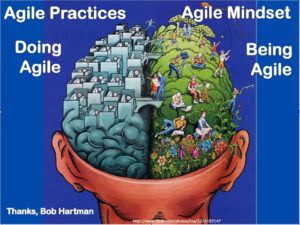It’s been a busy year on the Agile Alliance Blog, bringing you the latest in thought leadership and keeping you abreast of our activities. Here are the top 10 most popular blog posts to make sure you’re all caught up on 2017!
Many thanks to all the authors who contributed to our blog and shared their knowledge with our community.
1. What is Hybrid Agile, Anyway?
Every project has different needs. For those finding themselves in a mostly plan-driven environment, a hybrid approach can be a transition to more adaptability and delivery. For those already delivering and adapting aggressively, blending in some new techniques can raise your bar even higher.
2. Introducing the Agile Practice Guide
Agile Alliance and PMI joined forces to create an Agile Practice Guide to build a greater understanding of Agile practices, with emphasis on how Agile relates to the project management community.
 3. Embracing the Agile Mindset & Agile’s Core Principles
3. Embracing the Agile Mindset & Agile’s Core Principles
Agile thinking is not exclusively for software development and IT organizations, but rather it can provide a competitive advantage to any organization.
4. What do User Story Conversations Look Like?
User stories are placeholders for a conversation. Who should be included in those conversations? When do you have these conversations? What should you talk about? How do you remember what you said?
5. Pair Programming vs. Mob Programming
Pair programming or mob programming can boost productivity on any team — as long as they learn how to do it well.
6. Alignment of the Agile Practice Guide and the PMI Standards
This post discusses the development of the new Agile Practice Guide and its fit, alignment, and potential conflicts with other PMI standards documents including the upcoming PMBOK® Guide – Sixth Edition.
7. Technical Debt is a Systemic Problem
By treating technical debt as a systemic problem, we are more likely to understand its causes and deal with its effects.
8. Pitfalls of Planning Poker
Before you start debating story points vs. no estimates, let’s examine what can go wrong when a team uses Planning Poker with Story Points to estimate their work. The first misnomer is that Planning Poker is not an estimating tool.
9. Agile Retrospectives as a Tool for Team Learning
Agile retrospective is a vital part of the end-of-project process where team members meet to discuss what worked and what did not. Retrospectives are used to improve team efficiency so that they can better perform in future projects.
10. Why We All Use Timeboxes
A look at timeboxing, a technique that limits the time that people work on a task and helps them focus their efforts.



![[Case Study] Lessons from descaling 25 Scrum teams](https://www.agilealliance.org/wp-content/uploads/2024/12/descaling-teams-1200x630-1-150x150.jpg)



![[Case Study] Lessons from descaling 25 Scrum teams](https://www.agilealliance.org/wp-content/uploads/2024/12/descaling-teams-1200x630-1-300x158.jpg)

